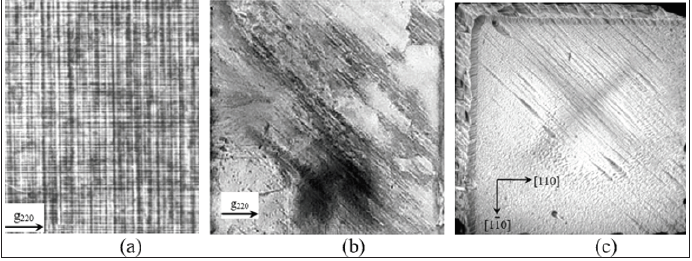- Submissions

Full Text
Academic Journal of Engineering Studies
Application of Double-Crystal X-Ray Difractometry Methods and Topography for Characterization of Isotopically Modified CVD Diamond Films
Romanov DA* and Kosushkin VG
Bauman Moscow State Technical University Kaluga Branch, Russia
*Corresponding author: Romanov DA, Bauman Moscow State Technical University Kaluga Branch, Russia
Submission: March 08, 2021 Published: March 25, 2021
.jpg)
ISSN:2694-4421 Volume1 Issue5
Abstract
technology for their growth has been demonstrated. The main structural defects (dislocations, stacking faults, second-phase inclusions, etc.) that occur in synthetic diamond crystals during their preparation have been identified.
Keywords: Double-crystal x-ray diffractometry; X-ray topography; Defects in the crystal structure; Epitaxial films; Isotopically modified films
Abbreviations: XRD: X-Ray Diffractometry; MDs: Misfit Dislocations; ES: epitaxial structures
Introduction
Crystals are the basis of numerous instruments and devices of modern technology. All
real crystals contain a variety of structural imperfections that strongly, sometimes cardinally
change the properties of crystals and have a direct impact on the operational characteristics
of devices made on their basis. To study the laws of formation and control of the real structure
of crystals a wide range of physical research methods are currently used. Double-crystal X-Ray
Diffractometry (XRD) and topography methods are widely used in laboratory practice as the
most accessible and relatively simple from a technical point of view. The use of these methods
in the study of epitaxial structures makes it possible to determine: structural perfection of
the substrate and film; the mismatch in the interplanar spacings of the crystal lattices of the
substrate and the film and their mutual misorientation; thickness of the epitaxial film over
the period of the intensity oscillation (Pendellösung); lattice mating coherence; the curvature
of the plate and, accordingly, the level of elastic stresses in the system, and also the change in
the thickness composition and the structure of the interphase boundary when processing the
swing curve using mathematical modeling methods.
In this research the capabilities of the XRD and topography methods are analyzed by the
example of the study of isotopically modified CVD diamond films, which, due to their unique
properties: high hardness, chemical and radiation resistance, low coefficient of thermal
expansion and high thermal conductivity, are increasingly used in various fields of science and
techniques [1,2]. The main structural defects (dislocations, stacking faults, micro segregation
growth bands, second phase inclusions, etc.) arising in crystals during their preparation were
identified. The formation of dislocation beams originating at the film-substrate interface was
discovered due to possible near-surface disturbances of the substrate and relaxation of elastic
macrostresses, which arise due to the mismatch between the periods of the crystal lattices
of the substrate and the film. In isotopically modified diamond films 13C(99.96%) grown on
diamond Ib substrates, the XRD method revealed a significant decrease in the crystal lattice
period (Δа/а)relax~ (1.1/1.2)·10-4. Data on the features of relaxation processes in epitaxial
CVD films of diamond and its crystallographic analogue of germanium are presented. Special
characteristics of plastic deformation in these materials due to specific distribution of elastic
stresses are revealed. The process of relaxation of elastic stresses in germanium structures at film thicknesses exceeding critical is accompanied by formation
of 60-degree Misfit Dislocations (MDs) at the interphase boundary
(Figure 1a); [3]. Traces of plastic deformation with the formation
of MDs in Epitaxial Structures (ES) 13C/natC (001) with a film
thickness of ~ 80μm, almost two orders of magnitude greater than
the critical value tc~1.1μm [4], on the x-ray topogram (Figure 1b)
are not visible. Only traces of mechanical processing on the reverse
side of the substrate are detected, along the direction [100], which
is the direction of the light polishing of diamond [5]; (Figure 1c).
This seems to be connected with the low epitaxy temperature (950
°С). Compared to the melting temperature of diamond, dislocations
are inactive, and the effective plastic deformation observed in ES
germanium does not occur in the diamond film.
Figure 1:(a) X-ray topograms of ES Ge(B)/Ge(001)
(b) 13C/natC(001)
(c) and micrograph of ES diamond 13C/natC(001)

References
- Wandersande JW (1994) Properties and growth of diamond. L. The Inst Electric Eng p. 33.
- Ralchenko VG, Bolshakov AP (2017) Carbon photonics. In: Konov VI (Ed.), Nauka, Moscow, Russia, p. 9.
- Prokhorov IA, Voloshin AE, Romanov DA (2017) Crystallogr Rep 64(3): 369.
- Prokhorov IA, Voloshin AE, Ralchenko (2020) Crystallogr Rep 61(6): 945.
- Yurov V, Bushuev E, Bolshakov A (2017) Phys Status Solidi A 2017, 00, 1700177.
© 2021 Romanov DA. This is an open access article distributed under the terms of the Creative Commons Attribution License , which permits unrestricted use, distribution, and build upon your work non-commercially.
 a Creative Commons Attribution 4.0 International License. Based on a work at www.crimsonpublishers.com.
Best viewed in
a Creative Commons Attribution 4.0 International License. Based on a work at www.crimsonpublishers.com.
Best viewed in 







.jpg)






























 Editorial Board Registrations
Editorial Board Registrations Submit your Article
Submit your Article Refer a Friend
Refer a Friend Advertise With Us
Advertise With Us
.jpg)






.jpg)














.bmp)
.jpg)
.png)
.jpg)










.jpg)






.png)

.png)



.png)






